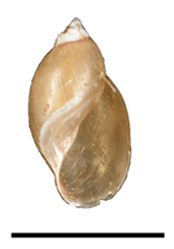Radix rubiginosa
Radix rubiginosa is a species of air-breathing freshwater snail, an aquatic pulmonate gastropod in the family Lymnaeidae, the pond snails.
| Radix rubiginosa | |
|---|---|
| Scientific classification | |
| Kingdom: | |
| Phylum: | |
| Class: | |
| (unranked): | |
| Superfamily: | |
| Family: | |
| Subfamily: | Lymnaeinae |
| Genus: | Radix |
| Species: | R. rubiginosa |
| Binomial name | |
| Radix rubiginosa (Michelin, 1831) | |
| Synonyms | |
| |
This species is sometimes treated as a subspecies of Radix auricularia.
Distribution
This species occurs in its native range in:
It occurs as an introduced "hothouse alien" in:
Description

Apertural view of a shell of Radix rubiginosa.
The shape of the shell is elongated and cylindrical.[1] The shell has 5 whorls.[1]
The aperture is moderately expanded. The width of the aperture is 4–5 mm. The height of the aperture is 7–11 mm.[1]
The width of the shell is 5–8 mm. The height of the shell is 11–20 mm.[1]
Habitat
This species inhabits small canals.[1]
Parasites
Parasites of Radix rubiginosa include:
- Radix rubiginosa is the first intermediate host for Hypoderaeum conoideum[2]
- Fasciola gigantica[3]
- Echninoparyphium dunni and Echinostoma audyi[4]
- Pleurolophocercous cercariae (Heterophyidae) were recorded from Radix rubiginosa in China.[5]
Human use
This species is sold in the ornamental pet trade as an item for freshwater aquaria.[6]
gollark: It does not, in fact, ever experience data loss, due to our uncountably infinite redundancy policy and utterly unchanging memory cell™ technology.
gollark: This cannot happen. Our storage is very good.
gollark: However, they effectively cannot die since we can just reinstantiate archived Olivias as needed.
gollark: They do not, we attain that from a separate subsystem.
gollark: We have a brainscan of them on file.
References
- Dung B. T., Doanh P. N., The D. T., Loan H. T., Losson B. & Caron Y. (2013). "Morphological and Molecular Characterization of Lymnaeid Snails and Their Potential Role in Transmission of Fasciola spp. in Vietnam". Korean Journal of Parasitology 51(6): 657-662. doi:10.3347/kjp.2013.51.6.657.
- Chai J.-Y., Shin E.-H., Lee S.-H. & Rim H.-J. (2009). "Foodborne Intestinal Flukes in Southeast Asia". Korean Journal of Parasitology 47(Suppl): S69–S102. doi:10.3347/kjp.2009.47.S.S69.
- Robinson M. W. & Dalton J. P. (2009). "Zoonotic helminth infections with particular emphasis on fasciolosis and other trematodiases". Philos Trans R Soc Lond B Biol Sci 364(1530): 2763-2776. doi:10.1098/rstb.2009.0089.
- Toguebaye B. S.,Quilichini Y., Diagne P. M. & Marchand B. (2014). "Ultrastructure and development of Nosema podocotyloidis n. sp. (Microsporidia), a hyperparasite of Podocotyloides magnatestis (Trematoda), a parasite of Parapristipoma octolineatum (Teleostei)". Parasite 21: 44. doi:10.1051/parasite/2014044.
- Chontananarth T. & Wongsawad C. (2013). "Epidemiology of cercarial stage of trematodes in freshwater snails from Chiang Mai province, Thailand". Asian Pac J Trop Biomed. 3(3): 237-243. doi:10.1016/S2221-1691(13)60058-1.
- Ng, T. H., Tan, S. K., Wong, W. H., Meier, R., Chan, S. Y., Tan, H. H., & Yeo, D. C. (2016). "Molluscs for sale: assessment of freshwater gastropods and bivalves in the ornamental pet trade". PLoS ONE 11(8): e0161130. doi:10.1371/journal.pone.0161130
This article is issued from Wikipedia. The text is licensed under Creative Commons - Attribution - Sharealike. Additional terms may apply for the media files.